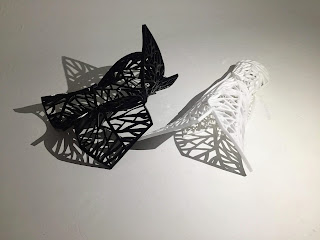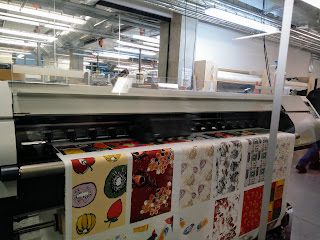Third Year: Project 1, Week 3
This week I have focused on the paper cutting I started last
week, developing these samples into maquettes in order to visualise them as
installation pieces.
To push the paper samples further, I had the paper designs
laser cut onto Perspex and fabric. I then heated the Perspex samples in the
heat press to mould them into 3D forms. The heating process allowed me to
manipulate the forms into objects resembling lampshades. This led me to
consider my pieces as a bespoke interior collection, drawing on the style of
one-off installation pieces.
 |
| Perspex samples, investigating shaddow. |
As well as working with hard materials such as Perspex, I have experimented with different weights and types of paper, from cartridge to tracing paper, to see how they respond to manipulation. I found that the thicker the paper, the less likely it was to tear, but the thinner paper cast some really ethereal shadows and shapes when photographed, which I loved. When laser cutting paper, I realised that testing is important, as the designs can be too thin and cut through the fragile surface.
To manipulate, I used thread to hold the paper in position,
whilst also creating added linear elements. I also used tape to keep them
together for ones where I wanted the paper to be the focal point.
 |
| Investigating the shaddows from paper pieces. |
Throughout this project, using paper has also led me to think about wallpaper, in particular the designs by Tracy Kendall. Her wallpaper is a mix of bespoke wallpaper more akin to art pieces, as well as more commercial styles. I love the way she manages to combine both the one-off, artisanal pieces with wallpaper which lends itself to production on a wider scale.
In addition to working in 3D on physical samples, I have
been editing my primary research to emulate the graphic and bold black and
white style of photographer Karl Blossfeldt. I am intrigued by the way he
captures line, geometry and nature within a monochrome palette, and this is
what I aimed to convey with my imagery, whilst retaining the unpredictable
quality of natural plant forms.
 |
| Bespoke wallpaper by Tracy Kendall. |
 |
| Graphic black and white photographs by Karl Blossfeldt. |
Continuing to experiment with different materials, I also
decided to embellish my screen-printed samples from the previous week, with
varying effects. I feel the samples which I have hand-stitched are most
effective as they have a tactile quality, and the contrast between the
screen-printing and the thread used in the stitching highlights the linear
qualities of the designs. Additionally, when using a limited colour palette, I feel
that tactility is important in my designs, adding another, more interactive
element.
Although my samples are all one-off and could be seen as sculptural
pieces, I invite people to handle them and feel the angles and contours. As my
process involves me playing with materials and feeling how they look, sometimes
more than seeing when deciding how to manipulate them, it’s critical to me that
this playfulness emanates from the final product, whatever it becomes. On the
other hand, the samples which I enhanced using machine stitch have less impact
and lack the juxtaposition between materials which I hoped to highlight through
my sampling.
 |
| Contrast between hand-stitched and machine embroidered samples. |
To take this project further, I would assess the effectiveness of the materials I have used thus far in manipulation. I visualise the project as having an interior context, so would carry on sampling in materials such as wood and varying types of paper to see which would be suitable for a collection of homewares such as lampshades. I would also like to introduce brighter pops of colour, to make the pieces more dynamic and highlight more of the movement within them.




Comments
Post a Comment